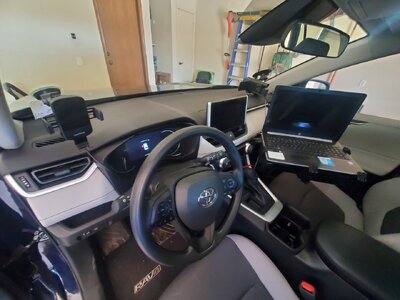I have overall, simplified my setup and thinking over the years so that chasing remains as stress free as I can make it. I no longer chase everything, go too crazy forecasting, stretch too far on conditional forecasts, dork with too much gear or apps, etc. My tone is to try to keep it fun, relaxing and minimize the bad stuff. If a setup starts to feel like a chore or bust risk, I am likely to bail before or during, and be happy even if I miss something.
I use Pivotal Weather for forecast and GRL3 on a tablet in the field, with quad screen layout of reflectivity, velocity, echotops, 3-hour rainfall and a bunch of data overlays for hail, lightning, frontal positions, etc. I exclusively use SPC mesoanalysis page for surface observations and RAP analsysis in the field. I run navigation on the car screen; google maps or the native garmin map which calls out approaching sideroads for me.
In regards to specific question areas posed:
Analysis paralysis: I've had it many times in the past, born of stress of cost vs. reward failures, and wanting to prevent repeats. I began overthinking to try to improve success rates. In the end I found overthinking was stressful without significantly improving success. Instead, simplifying how I thought about chasing and focusing on the desired experience I want from it minimized costs and increased the success rate.
“shorthand” forecasting process: I use the same set of questions, in order, for every forecast: Will I chase in that area? Will sufficient shear and moisture exist and overlap? Is environment unstable but at least slightly capped? Will there be reasonable chance for initiation? If those ingredients are not all confirmed, or still appear stored separately on the 'shelves', it is clear we are not having supercell cookies worth eating. Forecast over, chase dismissed. If we are possibly having delicious cookies, I work harder on the specifics of how they will be prepared (long forecast).
how long forecasting an event: For obvious 'classic' setups in terrain I like, < 1-2 hours. For subtle scenarios or those in my 'maybe' category, several hours, allowing for go/no go decision up to morning of. For longer distance or multiday chases, more effort before making the commitment. For monsoon, go outside and hope. For a backyward chase, go outside with little forecasting because why not?
reconciling competing model solutions (particularly HRRR): Each model has to be consistent for many runs to gain trust in the member, and models have to agree with each other for me to gain confidence something will happen. If models disagree I consider biases and check how well each initializes to reality, pick a favorite, and ignore the others until they correct. For CAMs, I ignore completely more than ~24 hours out, remain skeptical until 12 hours out, expect a minimum of ~6 consistent runs before willing to make decisions weighted to them.
composite parameters as shorthand: Not for me. This obfuscates initiation, quality, and so much more, etc.
data in the field: Almost no long term model use once in the field (maybe a peak at CAMs if there was a previous question of consistency resolving). I heavily use RAP model mesoanalysis and surface observation in the field to fine tune position before a chase starts. Once initiation starts I mainly focus on eyes and radar, and only return to mesoanalysis data if the storms available to me are not satisfactory and I need to relocate.
avoid biases: I don't go out of my way to avoid bias that relates to what I prefer. I do work a lot harder to remain aware of reality rather than forecast expectations after a few bad busts out of position from biased thinking.

